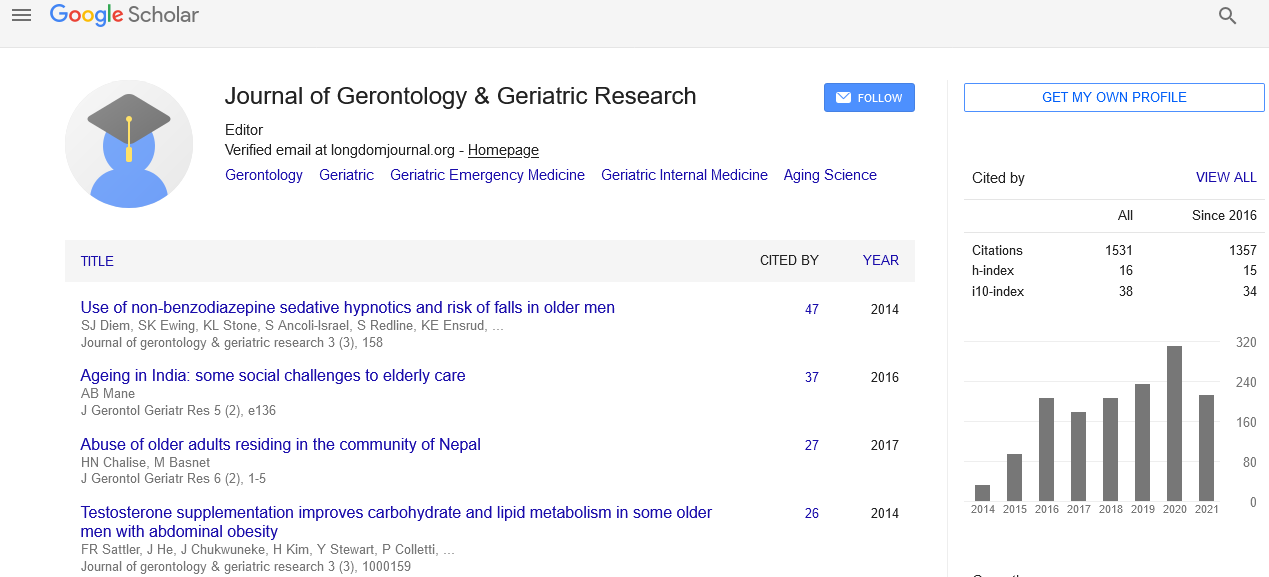PMC/PubMed Indexed Articles
Indexed In
- Open J Gate
- Genamics JournalSeek
- SafetyLit
- RefSeek
- Hamdard University
- EBSCO A-Z
- OCLC- WorldCat
- Publons
- Geneva Foundation for Medical Education and Research
- Euro Pub
- Google Scholar
Useful Links
Share This Page
Journal Flyer

Open Access Journals
- Agri and Aquaculture
- Biochemistry
- Bioinformatics & Systems Biology
- Business & Management
- Chemistry
- Clinical Sciences
- Engineering
- Food & Nutrition
- General Science
- Genetics & Molecular Biology
- Immunology & Microbiology
- Medical Sciences
- Neuroscience & Psychology
- Nursing & Health Care
- Pharmaceutical Sciences
Perspective - (2022) Volume 11, Issue 3
Treatment for Neurological Disorders in Elders
G Suresh Babu*Received: 03-Mar-2022, Manuscript No. jggr-22-16484; Editor assigned: 05-Mar-2022, Pre QC No. P-16484; Reviewed: 19-Mar-2022, QC No. Q-16484; Revised: 24-Mar-2022, Manuscript No. R-16484; Published: 31-Mar-2022, DOI: 10.35248/2167-7182.22.11.605
Introduction
The nervous system is in charge of body control and communication. It is made up of a complex network of nerves and specialised cells. According to the World Health Organization, neurological disorders are diseases of the central and peripheral nervous systems (WHO). Neurological disorders affect the brain, cranial nerves, peripheral nerves, and spinal cord, and include neurotraumatic diseases such as stroke and spinal cord injury, neurodegenerative diseases such as Alzheimer's disease (AD) and Parkinson's disease (PD), and neuropsychological disorders such as depression and schizophrenia. Acute and slow neuron degeneration characterises neurological disorders, leading to brain malfunction and neuronal cell death. Some of the underlying molecular mechanisms of neurodegeneration include changes in phospholipid metabolism, accumulation of lipid peroxides, mitochondrial dysfunction, protein misfolding, abnormal protein aggregation, decreased cellular energy levels, disturbed calcium (Ca2+) homeostasis, excitotoxicity, oxidative stress, neuroinflammation, dysregulated hormonal signalling, and apoptosis [1,2].
Description
Neurological diseases are a prominent cause of morbidity and mortality around the world. The societal burden of neurological disorders has increased as the prevalence of these diseases has increased, which is connected to an ageing population. There are currently no viable therapy alternatives for these diseases. As a result, it's vital to find and develop new therapeutic strategies capable of preventing or reversing neuronal loss by addressing the fundamental causes of neurodegeneration and neuronal cell death. Plants and other natural products have been examined as safe and naturally occurring sources of neuroprotective secondary metabolites. Secondary metabolites - and -asarone can be found in high amounts in the rhizomes of the medicinal plant Acorus calamus (L.).
Antioxidant, anti-inflammatory, anti-apoptotic, anticancer, and neuroprotective properties are among the pharmacological activities of - and -asarone. This paper will provide an overview of current research on the therapeutic potential of - and -asarone in the treatment of neurological illnesses, particularly neurodegenerative diseases such as Alzheimer's disease, Parkinson's disease, cerebral ischemia disease, and epilepsy. According to current research, -and -asarone protect neurons by lowering oxidative stress, abnormal protein building, neuroinflammation, neurotrophic factor shortage, increasing neuronal cell survival, and activating a variety of neuroprotective signalling pathways. Despite the fact that - and -asarone have beneficial effects in vitro and in vivo animal studies, more research is needed to translate laboratory findings into safe and effective therapies for patients with Alzheimer's disease, Parkinson's disease, and other neurological and neurodegenerative diseases [3-5].
Conclusion
Asarone's pharmacological features contribute to its protective effects against a number of neurotoxic stresses. The antiinflammatory properties of and asarone have been attributed to a variety of mechanisms of action, including antioxidant properties, regulation of various neuroprotective signalling pathways, reduction of aggregate formation and promotion of clearance of pathogenic protein aggregates, anti-inflammatory properties, inhibition of microglial activation, activation of NTFsmediated neuroprotection and modulation of the modulation of the modulation of the modulation of the modulation of the modulation of these neuroprotective qualities make – and -asarone promising therapeutic medicines for Alzheimer's disease, Parkinson's disease, cerebral ischemia, and epilepsy, among other neurological diseases. Despite encouraging preclinical findings, successful translation of results from the bench to the clinic has yet to be achieved due to the potential toxicity of - and -asarone and their limited bioavailability. The development of innovative delivery systems may reduce - and -asarone toxicity, resulting in considerable therapeutic benefits for patients.
REFERENCES
- Maiti P, Manna J, Dunbar LG. Current understanding of the molecular mechanisms in Parkinson’s disease: Targets for potential treatments. Transl Neurodegener. 2017;6:1-35.
- Michel Pp, Hirsch CE, Hunot S. Understanding dopaminergic cell death pathways in Parkinson disease. Neuron. 2016; 90:675-691.
- Guo Y, Li P, Guo Q, Shang K, Yan D, Du S,et al. Pathophysiology and biomarkers in acute ischemic stroke-a review. Trop J Pharm Res. 2014;12:1097-1105.
- Pearson SNJ, Patel M. Metabolic dysfunction and oxidative stress in epilepsy. Int J Mol Sci. 2017;18:2635.
- Hussain R, Zubair H, Pursell S, Shahab M. Neurodegenerative diseases: regenerative mechanisms and novel therapeutic approaches. Brain Sci. 2018;8:177.
Google Scholar, Crossref, Indexed at
Google Scholar, Crossref, Indexed at
Google Scholar, Crossref, Indexed at
Google Scholar, Crossref, Indexed at
Citation: Babu GS (2022) Treatment for Neurological Disorders in elders. J Gerontol Geriatr Res. 11: 605.
Copyright: © 2022 Babu GS. This is an open-access article distributed under the terms of the Creative Commons Attribution License, which permits unrestricted use, distribution, and reproduction in any medium, provided the original author and source are credited.


